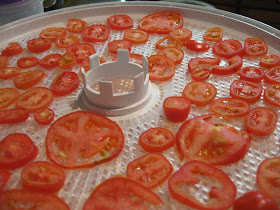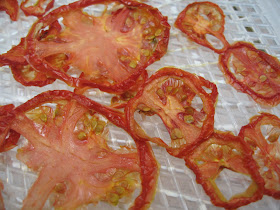 | |
| This is dairy kefir grains with apricots |
So, back in June, I visited a raw dairy farm in Pennsylvania and picked up some dairy kefir grains. I wrote about kefir back then as experiments into a super food. Since then we grew and doubled are number of kefir grains, split them and gave half to a friend.
Dairy kefir, though, takes regular care and feeding to maintain, and you are constantly producing more kefir. Since we also make our own yogurt, I found myself just keeping the kefir alive by replacing it's milk once a week, rather than drinking most of the kefir product. The plan was to dry the kefir grains, and they can be stored dry for up to a few years.
But, then I decided to investigate whether we could use our dairy kefir grains to ferment other things. I'd heard that you could ferment coconut water, for example, and make a non-dairy kefir. Could I use the grains I have to do that?
The answer is: kinda. You can usually convert the dairy grains to instead take their food from another source of carbohydrates, but there is a high chance they'll die off and they will inevitably stop growing in other mediums. It's recommended, then, that you only use spare grains for this kind of experimentation.
Once you convert your grains to feed off of sugar, though, you can then make kefir soda pop - a fizzy, fruit-drink high in probiotics. Many people reported success of keeping their converted grains producing soda for over a year, though they had no growth in grains.
Non-dairy kefir is generally called water kefir, and it is normally produced by an altogether different symbiotic community of bacteria and yeast (SCOBY) than the dairy kefir SCOBY that originates in the Caucus mountains. As best as I can tell, there are at least two distinct SCOBYs that produce water kefir, called by different names, but most commonly sweet water kefir (SKG) and ginger beer plant. The SKG are also called Tomi grains and seem to originate in Mexico.
To grow a SCOBY with a sugar-water solution, you need to use a real water kefir SCOBY. I have ordered some of that, so we can see what it is like.. but in the meantime, I went about and converted some dairy grains.
I won't try to pass on the science, as I don't fully understand it and it's documented on the internet. This site is the most authoritative, but also overwhelming, site on kefir on the Internet, by all accounts: Dom's Kefir Website. Another website that has a very detailed FAQ and seems more accessible is Yemoos Nourishing Cultures. Searches on "water kefir", "converting dairy kefir to water kefir", "kefir soda pop", etc. will all yield lots of results.
Instead, here's the nutshell of what I've learnt, specifically about creating water kefir from dairy grains.
- It generally takes several days to convert the grains to eat non-dairy sugars, many sites citing up to 5 days. Mine started fermenting in about 48 hours.
- Once converted, it is difficult to convert them back to dairy products. They may die off, and they most certainly won't continue to grow.
- The base solution for water kefir contains: non-chlorinated water (spring or hard well water is recommended), some dry fruit, some sugar (about 10-15% solution). Some recommend adding egg shells, baking soda, and if using refined sugar, a bit of molasses.
- You need to use the most pure water you can, spring or well water. If you only have city water, you can let the chlorine evaporate by setting the water out overnight. At a minimum, you need to get rid of the cholorine or it will kill off your SCOBY. Since we aren't on city water, we haven't researched this fully. And hard water is recommended, which is why they add egg shells to the mix.
- Varying the types of fruits and sugar you use will vary the taste of your water kefir.
- After it has fermented, you strain out the grains and other ingredients and restart the grains in new sugar water. Put the water kefir in the fridge, or...
- many people then take the fermented base and add in in a 50/50 solution with some sort of fruit juice for a second ferment. The second fermentation will feed the bacteria and yeast that are in the water kefir solution with a whole new set of sugars. This is generally what is called soda pop kefir.
- Some people just use one fermentation and start their based with fruit juice, however, this can discolour the grains. SKG also doesn't seem to like to feed on fruit juice, and so the single fermentation is usually done only when using converted grains.
- You can feed your converted grains any kind of carbohydrates - various dried fruits, different sugars, to include honey, coconut water, and others. You can't use Stevia, as it doesn't have carbohydrates to feed on. Most sites recommend unprocessed sugars like Turbinado, Rapadura, etc.
- Converted grains produce a slightly more alcoholic drink than water kefir from SKG. Sites seem to provide numbers of 1-2% for converted grains and 0.5-1% for SKG. However, the alcohol content is highly dependent on the type of sugars and the length of fermentation.
- You can ferment water kefir either air tight, loosely covered, or opened, and this also effects the end product.
- Once the solution is put in the fridge, the fermentation slows way down and you can control the level of fizz that way. The Art of Fermentation recommends using some solution in type 2 (so it doesn't leach chemicals) old soda bottles so that you can feel the level of fermentation with your hands. Everything else says don't fill about the 3/4 mark in the tight jar, but I think this also assumes that you still monitor things and put in the fridge at exactly the right moment.
- As far as timing goes, both for taste and for CO2 issues, they say to ferment the grains for 24-28 hours, then do the second ferment at room temperature for 12-48 hours. After this time, you need to put them in the fridge because of the CO2 build up. Also, the ambient temperature of the room really matters, so in Summer you need to exercise more caution.
 | |
| Comparing the kefir alone fermenting with a mix of juice and kefir |
Here's our first experiments:
- I took our dairy grains and washed them several times. Then added them to water straight from our well, to get the most minerals possible, with sugar-in-the-raw, a little molasses, dried apricots, and an egg shell. I put this in a mason jar, filling only 3/4 full, and tightly sealed the jar.
- It took about 48 hours to get distinct bubbles rising, and after 72 hours we divided the solution. We put some in the fridge. It was only mildly fizzy, but had a wonderful taste. We took some solution and left it to sit by itself, and we created a third solution of 50/50 with apple juice.
- The base solution has continued to ferment but slowly.
- The 50/50 solution is fermenting rapidly and has a strong show of bubbles after 24 hours. Tasting it after 24 hours, it still has strong apple juice flavour, but it is definitely not as sweet.
- We have started a second base solution using sucanat (a dark unprocessed sugar), fig, and cranberries. This solution is really quite dark and when we started fermenting it, it was sickeningly sweet tasting. It began fermenting gently after about 24 hours.
- My biggest concern right now is controlling the CO2. I don't have a strong understanding of that process or controls, and there a good risks associated with explosion of glass and sugar in the kitchen! And if you keep releasing the CO2, as I've done on some of these, then eventually your fermenting dies down and you loses the bubbles. One good, but kind of expensive, option seems to be flip-top soda/beer bottles for the second ferment and storage. Still, there doesn't seem to be really good information about how to calculate the liquid levels to avoid problems, and I now suspect that's because it's pretty complicated.
- The consensus I found in the fermentation Real Food world was to fill the jar 3/4 full for the first ferment with the grains, then when you put them in a soda jar, to leave 1" of headspace. Their consensus seemed to be that less headspace was more dangerous, but I had home brewers tell me otherwise. Another thing they recommended it to put the fermenting bottles in a place that if they do explode, it's contained. :)
- In my first batches, I kept burping them because I was worried about the CO2. They did have a nice flavour to them, fermented, sweet but not too sweet. But, with all my opening and closing, they definitely went flat. The other thing was that I took one jar that had the mason lid bulging and put it in the fridge, but 12 hours later it was flat. I am assuming that the jar wasn't quite airtight - not sure.
 | |
| Our second batch used sucanat - an unprocessed sugar - that left the grains dark brown! |















